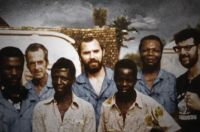
有些人自愿置身于疾病爆发的前线,尤其是要直面我们从未见过的敌人,我觉得无论说他们有多勇敢都不为过。没有关于一种疾病如何在人与人之间传播的信息,你很难保护自己。你唯一的选择就是,穿上一身生化服并相信它将保护你的安全。
如果你是一名卫生工作者,在这种情况下,你经常会面对你无法帮助的病人。毕竟,我们只有知道了一种疾病之后才能去治疗它。这就是病毒猎人登场的地方。
病毒猎人面临着一项几乎不可能完成的任务:查清神秘的病原体从何而来,它是如何传播的,以及如何阻止它。虽然他们都是训练有素的科学家和研究人员,但他们必须也是侦探。一个优秀的病毒猎人必须寻找并跟踪线索,直到他们抓住坏蛋为止。想想电视剧《真探》(True Detective),不过请代入显微镜下的病原体,而不是连环杀手。
病毒猎人正在世界各地从事着了不起的工作来阻止传染病(包括由细菌和其他病原体引起的疾病——病毒猎人这个名字有点误导)。我想向你们介绍两个尤其令我感到鼓舞的例子:一位医生追踪到了人类历史上最臭名昭著的疾病之一;一组摇滚明星般的科学家一接到通知就奔赴疾病爆发前线。
发现埃博拉的现实版福尔摩斯
当我想象一位典型的病毒猎人时,一个名字在我脑海中浮现:彼得 · 皮奥特博士(Dr. Peter Piot)。我在这些年里与彼得相处了很长时间,听他讲让他出名的那件事,我从来不会感到厌倦。
视频:https://v.qq.com/x/page/v0867po11yl.html
彼得27岁时,他所供职的那间比利时实验室收到一份血液样本,它被当时一种未知的疾病感染。1976年,大多数人认为传染病已成为历史,但卫生官员正开始为扎伊尔(今天称为刚果民主共和国)一种可致人流血而死的新疾病忧虑。彼得和一组来自世界各地的研究人员一起工作,他们要识别出这种神秘的病毒,也就是我们如今知道的埃博拉。
但是,在显微镜下识别病毒只是阻止疾病爆发所需许多步骤中的第一步。因此,在彼得并不知道自己面对的是什么的情况下,他前往扎伊尔寻找零号病人。他和同事们驾驶一辆路虎挨个村庄搜集信息,关于谁得病以及他们在症状出现之前都去过哪里。
最终,一群修女告诉彼得,她们注意到人们似乎是在参加完死于这种疾病之人的葬礼后得病的。这个情报引出了一个关键的发现:扎伊尔的哀悼者会给死者沐浴。在他们触摸了尸体之后——尸体上通常都是血——哀悼者最终会揉眼睛或者把手指放进嘴里。一个星期后,他们便会生病。
这帮助彼得和其他病毒猎人懂得埃博拉是通过接触病人的体液传播的。一旦我们知道了这种疾病是如何传播的,限制其扩散及在到达临界水平之前阻止其爆发就会容易许多。
彼得这段与埃博拉有关的经历,只是他抗击传染病漫长职业生涯的开始。他是最早研究艾滋病的微生物学家之一,并在1995年成为了联合国艾滋病规划署的首位执行主任。在他13年的任期内,从发现最早的治疗方法到大流行高峰期,他协调全球各方对艾滋病做出反应。他曾在伦敦帝国理工学院短暂工作并成为我们基金会的学者,随后他成为了伦敦卫生与热带医学院的院长并任职至今。
病毒猎人复仇者联盟
彼得可不是伦敦卫生与热带医学院里唯一的病毒猎人。这所学校也是英国公共卫生快速支持小组(简称RST)的大本营——这是一群科学家超级英雄,他们前往疾病爆发地区帮助当地政府阻止传染病。
视频:https://v.qq.com/x/page/b0867t95bz9.html
在创建后仅仅两年多的时间里,RST已经在7个国家协助控制了11次疾病爆发。这个团队处理过各样的情况,从孟加拉国罗辛亚难民营的白喉爆发到马达加斯加的瘟疫爆发。
RST的工作机制是这样的:一旦确定疾病暴发,当地政府(或者在极少数情况下,世界卫生组织)就会请求他们的帮助。不是每次疾病爆发都需要每个团队成员的参与,有时候你需要流行病学家和数据科学家,而不是微生物学家,所以第一步是确定需要谁去。然后,被选中的小组成员有48小时的时间准备签证,收拾好所有特殊设备抵达机场,登上飞往疾病爆发区的航班。
抵达之后,他们要么建立一个移动实验室,要么用他们的设备来补足当地已有的设备。然后,这个团队会开始协助当地的卫生官员。他们拥有的工具比彼得在1976年时用的要高科技许多(包括被用来解码病毒基因组成的基因测序技术)。这项技术有助于RST与当地专家合作,锁定疾病爆发的源头并限制其蔓延。
一次典型的部署会持续六周。如果疫情在六周后仍在继续,当前的团队将返回伦敦,再由一个新的团队取代他们的位置。例如,自刚果民主共和国最近的埃博拉疫情开始以来,RST便一直在当地开展实地工作。当他们不在现场的时候,研究小组会将时间用于研究如何更好地应对疾病爆发,以及帮助各国提高控制疾病紧急情况的能力。
英国投资了这样一个团队实在令我高兴,快速支持小组的工作是一个全球联盟的重要组成部分,它让我们所有人更加安全。我们不知道下一次重大疾病爆发将在何时何地出现。它可能在下个月、下个十年或下个世纪到来。在一个可以在不到一天的时间里飞到几乎任何地方的世界里,没有人能保证下一场流行病将继续局限在你所处世界的另一端。应对疾病的能力对于保护世界免受下一次流行病的影响至关重要,因此我希望更多的国家可以跟随英国的步伐。
点击下图了解更多我的场上英雄
Meet the Virus Hunters
These scientists are doing amazing work all over the world to stop infectious diseases like Ebola.
It’s hard for me to overstate how brave people who willingly put themselves on the frontlines of outbreaks are -- especially when you’re up against an enemy we haven’t seen before. Without any information about how a disease jumps from person to person, it’s difficult to protect yourself. Your only option is to put on a biohazard suit and trust that it will keep you safe.
If you’re a health worker in a situation like that, you’re often faced with patients you can’t help. We can’t treat a disease until we know what it is, after all. That’s where virus hunters come in.
Virus hunters are given a near-impossible task: find out where a mystery pathogen came from, how it’s transmitted, and how to stop it. Although they’re scientists and researchers by training, they also have to be detectives. A good virus hunter must look for clues and follow leads until they catch the bad guy. Think True Detective, but with microscopic pathogens instead of serial killers.
Virus hunters are doing amazing work all over the world to stop infectious diseases (including those caused by bacteria and other pathogens -- the name is bit a misleading!). I want to introduce you to two examples that I find particularly inspiring: the doctor who tracked down one of the most infamous diseases in human history, and a team of rock star scientists that deploys to outbreak zones on a moment’s notice.
The real-life Sherlock Holmes who helped discover Ebola
When I picture the quintessential virus hunter, one name comes to mind: Dr. Peter Piot. I’ve spent a lot of time with Peter over the years, and I never get tired of hearing him talk about the case that made him famous.
Peter was just 27 years old when the Belgian lab where he was working received a blood sample infected with a then-unknown disease. In 1976, most people thought infectious diseases were a thing of the past -- but health officials were starting to worry about a new sickness in Zaire (today called the Democratic Republic of the Congo) that caused people to bleed until they died. Peter and a team of researchers around the world worked together to identify the mystery virus, which we now know as Ebola.
But identifying a virus on a microscope is only the first of many steps to stopping an outbreak. So, with no real idea of what he was up against, Peter headed to Zaire to hunt for patient zero. He and his colleagues drove from village to village in a Land Rover, collecting information about who was sick and where they had been before symptoms appeared.
Eventually, Peter spoke to a group of nuns who noticed that people seemed to get sick after they attended the funeral of someone who died from the disease. That tip led to a key revelation: Zairean mourners washed their dead. After they touched the bodies -- which were often covered in blood -- the mourners would eventually rub their eyes or put their fingers in their mouths. A week later, they’d get sick.
That understanding helped Peter and the other virus hunters understand that Ebola spreads through contact with a sick person’s body fluids. Once we knew how the disease was transmitted, it was a lot easier to limit its spread and stop the outbreak before it reached a critical level.
Peter’s experience with Ebola was just the beginning of a long career fighting infectious disease. He was one of the first microbiologists to study AIDS, and in 1995, he became the founding executive director of UNAIDS. During his 13-year tenure, he coordinated the global response to HIV/AIDS through the discovery of the first treatments for the disease and the peak of the pandemic. After a brief stint at the Imperial College London and as a fellow with our foundation, he became the director of the London School of Hygiene and Tropical Medicine where he still teaches today.
The Avengers of virus hunters
Peter isn’t the only virus hunter in residence at the London School of Hygiene and Tropical Medicine, though. The school is also home to the UK Public Health Rapid Support Team (or RST) -- a heroic supergroup of scientists who deploy to outbreak zones to help local governments stop infectious diseases.
In just a little more than two years since it was created, the RST has already assisted in controlling 11 outbreaks in seven countries. The team has deployed to scenarios ranging from a diphtheria outbreak at a Rohingya refugee camp in Bangladesh to a plague flareup in Madagascar.
Here’s how the RST works: as soon it becomes clear that an outbreak is underway, the local government (or, in rare cases, the WHO) requests their help. Not every team member is needed for every outbreak -- sometimes you need an epidemiologist and a data scientist but not a microbiologist -- so the first step is to identify who needs to go. The chosen team then has 48 hours to get their visas squared away, pack up any special equipment, and get to the airport for their flight to the outbreak zone.
Once on the ground, they either build a mobile laboratory or set up their equipment to supplement what’s already there. The team then gets to work supporting local health officials. The tools they have at their disposal are a lot more high-tech than the ones Peter used back in 1976 (including gene sequencing, which they use to decode the genetic makeup of viruses). This technology helps the RST work with local experts to target the origin of the outbreak and limit its spread.
A typical deployment lasts six weeks. If the outbreak is still ongoing at the end of that period, the current team heads home to London, and a new team takes their place. For example, the RST has been on the ground in the Democratic Republic of the Congo since the beginning of the latest Ebola epidemic there. When they’re not in the field, the team spends their days researching how to better respond to outbreaks and helping countries improve their capacity to control disease emergencies.
I’m really glad that the United Kingdom invested in a team like this, the Rapid Support Team’s work is an important part of a global coalition that makes all of us safer. We don’t know when -- or where -- the next major disease outbreak will emerge. It could arrive next month, next decade, or next century. And in a world where you can fly nearly anywhere in less than a day, there are no guarantees the next epidemic will remain confined to the other side of the world from you. The ability to respond to a disease is crucial for protecting the world from the next pandemic, and I hope more countries follow the U.K.’s lead.
*免责声明:本站文章图文版权归原作者及原出处所有 ,文章内容为作者个人观点,并不代表本网站。如果您发现网站上有侵犯您的知识产权的作品,请与我们取得联系,我们会及时修改或删除。




